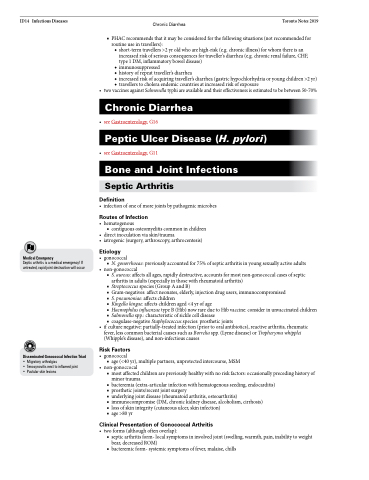Page 614 - TNFlipTest
P. 614
ID14 Infectious Diseases
Chronic Diarrhea Toronto Notes 2019
■ PHAC recommends that it may be considered for the following situations (not recommended for routine use in travellers):
◆ short-term travellers >2 yr old who are high-risk (e.g. chronic illness) for whom there is an increased risk of serious consequences for traveller’s diarrhea (e.g. chronic renal failure, CHF, type 1 DM, inflammatory bowel disease)
◆ immunosuppressed
◆ history of repeat traveller’s diarrhea
◆ increased risk of acquiring traveller’s diarrhea (gastric hypochlorhydria or young children >2 yr) ◆ travellers to cholera endemic countries at increased risk of exposure
• twovaccinesagainstSalmonellatyphiareavailableandtheireffectivenessisestimatedtobebetween50-70% Chronic Diarrhea
• seeGastroenterology,G16
Peptic Ulcer Disease (H. pylori)
• seeGastroenterology,G11
Bone and Joint Infections
Septic Arthritis
Definition
• infection of one of more joints by pathogenic microbes
Routes of Infection
• hematogenous
■ contiguous osteomyelitis common in children
• directinoculationviaskin/trauma
• iatrogenic(surgery,arthroscopy,arthrocentesis)
Etiology
• gonococcal
■ N. gonorrhoeae: previously accounted for 75% of septic arthritis in young sexually active adults
• non-gonococcal
■ S. aureus: affects all ages, rapidly destructive, accounts for most non-gonococcal cases of septic
arthritis in adults (especially in those with rheumatoid arthritis)
■ Streptococcus species (Group A and B)
■ Gram-negatives: affect neonates, elderly, injection drug users, immunocompromised
■ S. pneumoniae: affects children
■ Kingella kingae: affects children aged <4 yr of age
■ HaemophilusinfluenzaetypeB(Hib)nowrareduetoHibvaccine:considerinunvaccinatedchildren ■ Salmonella spp.: characteristic of sickle cell disease
■ coagulase-negative Staphylococcus species: prosthetic joints
• ifculturenegative:partially-treatedinfection(priortooralantibiotics),reactivearthritis,rheumatic fever, less common bacterial causes such as Borrelia spp. (Lyme disease) or Tropheryma whipplei (Whipple’s disease), and non-infectious causes
Risk Factors
• gonococcal
■ age (<40 yr), multiple partners, unprotected intercourse, MSM
• non-gonoccocal
■ most affected children are previously healthy with no risk factors: occasionally preceding history of
minor trauma
■ bacteremia (extra-articular infection with hematogenous seeding, endocarditis)
■ prosthetic joints/recent joint surgery
■ underlying joint disease (rheumatoid arthritis, osteoarthritis)
■ immunocompromise (DM, chronic kidney disease, alcoholism, cirrhosis)
■ loss of skin integrity (cutaneous ulcer, skin infection)
■ age>80yr
Clinical Presentation of Gonococcal Arthritis
• twoforms(althoughoftenoverlap):
■ septic arthritis form- local symptoms in involved joint (swelling, warmth, pain, inability to weight
bear, decreased ROM)
■ bacteremic form- systemic symptoms of fever, malaise, chills
Medical Emergency
Septic arthritis is a medical emergency! If untreated, rapid joint destruction will occur
Disseminated Gonococcal Infection Triad
• Migratory arthralgias
• Tenosynovitis next to inflamed joint • Pustular skin lesions


